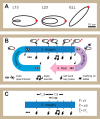Timing of continuous motor imagery: the two-thirds power law originates in trajectory planning
- PMID: 25609105
- PMCID: PMC4416550
- DOI: 10.1152/jn.00421.2014
Timing of continuous motor imagery: the two-thirds power law originates in trajectory planning
Abstract
The two-thirds power law, v = γκ(-1/3), expresses a robust local relationship between the geometrical and temporal aspects of human movement, represented by curvature κ and speed v, with a piecewise constant γ. This law is equivalent to moving at a constant equi-affine speed and thus constitutes an important example of motor invariance. Whether this kinematic regularity reflects central planning or peripheral biomechanical effects has been strongly debated. Motor imagery, i.e., forming mental images of a motor action, allows unique access to the temporal structure of motor planning. Earlier studies have shown that imagined discrete movements obey Fitts's law and their durations are well correlated with those of actual movements. Hence, it is natural to examine whether the temporal properties of continuous imagined movements comply with the two-thirds power law. A novel experimental paradigm for recording sparse imagery data from a continuous cyclic tracing task was developed. Using the likelihood ratio test, we concluded that for most subjects the distributions of the marked positions describing the imagined trajectory were significantly better explained by the two-thirds power law than by a constant Euclidean speed or by two other power law models. With nonlinear regression, the β parameter values in a generalized power law, v = γκ(-β), were inferred from the marked position records. This resulted in highly variable yet mostly positive β values. Our results imply that imagined trajectories do follow the two-thirds power law. Our findings therefore support the conclusion that the coupling between velocity and curvature originates in centrally represented motion planning.
Keywords: equi-affine geometry; motor control; motor imagery; trajectory planning; two-thirds power law.
Copyright © 2015 the American Physiological Society.
Figures






Similar articles
-
Complex unconstrained three-dimensional hand movement and constant equi-affine speed.J Neurophysiol. 2009 Feb;101(2):1002-15. doi: 10.1152/jn.90702.2008. Epub 2008 Dec 10. J Neurophysiol. 2009. PMID: 19073811
-
Fitts's Law violation and motor imagery: are imagined movements truthful or lawful?Exp Brain Res. 2010 Mar;201(3):607-11. doi: 10.1007/s00221-009-2072-2. Epub 2009 Nov 11. Exp Brain Res. 2010. PMID: 19904529
-
Affine differential geometry analysis of human arm movements.Biol Cybern. 2007 Jun;96(6):577-601. doi: 10.1007/s00422-007-0145-5. Epub 2007 Apr 4. Biol Cybern. 2007. PMID: 17406889 Free PMC article.
-
Role of the Cerebellum in the Construction of Functional and Geometrical Spaces.Cerebellum. 2024 Dec;23(6):2538-2563. doi: 10.1007/s12311-024-01693-y. Epub 2024 Apr 16. Cerebellum. 2024. PMID: 38625534 Review.
-
Biological kinematics: a detailed review of the velocity-curvature power law calculation.Exp Brain Res. 2025 Apr 3;243(5):107. doi: 10.1007/s00221-025-07065-0. Exp Brain Res. 2025. PMID: 40178611 Free PMC article. Review.
Cited by
-
On the Application of Developmental Cognitive Neuroscience in Educational Environments.Brain Sci. 2022 Nov 4;12(11):1501. doi: 10.3390/brainsci12111501. Brain Sci. 2022. PMID: 36358427 Free PMC article.
-
Does the Cerebellum Implement or Select Geometries? A Speculative Note.Cerebellum. 2020 Apr;19(2):336-342. doi: 10.1007/s12311-019-01095-5. Cerebellum. 2020. PMID: 31898281
-
Hyperalignment of motor cortical areas based on motor imagery during action observation.Sci Rep. 2020 Mar 24;10(1):5362. doi: 10.1038/s41598-020-62071-2. Sci Rep. 2020. PMID: 32210277 Free PMC article.
-
A Vexing Question in Motor Control: The Degrees of Freedom Problem.Front Bioeng Biotechnol. 2022 Jan 17;9:783501. doi: 10.3389/fbioe.2021.783501. eCollection 2021. Front Bioeng Biotechnol. 2022. PMID: 35111733 Free PMC article.
-
Mutual human-robot understanding for a robot-enhanced society: the crucial development of shared embodied cognition.Front Artif Intell. 2025 Jul 3;8:1608014. doi: 10.3389/frai.2025.1608014. eCollection 2025. Front Artif Intell. 2025. PMID: 40678782 Free PMC article. Review.
References
-
- Van Beers RJ, Haggard P, Wolpert DM. The role of execution noise in movement variability. J Neurophysiol 91: 1050–1063, 2004. - PubMed
-
- Blakemore SJ, Sirigu A. Action prediction in the cerebellum and in the parietal lobe. Exp Brain Res 153: 239–245, 2003. - PubMed
-
- Chiew M, LaConte SM, Graham SJ. Investigation of fMRI neurofeedback of differential primary motor cortex activity using kinesthetic motor imagery. Neuroimage 61: 21–31, 2012. - PubMed
Publication types
MeSH terms
LinkOut - more resources
Full Text Sources
Other Literature Sources

